In a November 19 titled “Yardeni And The Lengthy Historical past of Inventory Market Prediction Issues,” Lance Roberts, the Chief Funding Strategist for RIA Advisors, wrote that I’m a permabull. The slant of his article was essential of each my upbeat Roaring 2020s forecast and my usually optimistic outlook for the financial system and inventory market:
“In conclusion, whereas Yardeni’s optimistic forecast is engaging, a number of dangers might derail this bullish outlook. First, historic precedents remind us that unexpected financial downturns can reverse market momentum even throughout seemingly unstoppable development. As famous, Yardeni made bullish forecasts beforehand, just for financial realities to undermine these projections.”
Am I a permabull? Responsible as charged! In response to the thought-provoking bearish views of the permabears, I attempt to present some stability by analyzing what might go proper. Usually, I discover that the permabears have missed one thing of their analyses. Since they intensify the negatives, they usually fail to notice the positives or they put adverse spins on what’s basically constructive. I hardly ever have something so as to add to the bearish case as a result of the bears’ analyses are usually so complete. So my makes an attempt to supply stability usually trigger me to intensify the positives whereas nonetheless acknowledging the negatives.
Therefore, I’m usually known as a permabull, which I take as a praise. Once I die, I would love my tombstone to state: “Ed Yardeni, 1950-2050. He was normally bullish and normally proper!” Whereas my optimism on the long-term outlooks for the US financial system and inventory market is commonly criticized, that’s all proper by me as a result of it’s usually warranted: The US financial system usually grows at a stable tempo, and the inventory market has been on a bullish long-term uptrend because of this.
Contemplate the next:
(1) The previous half-century has introduced solely six bear markets
Once I began my first job on Wall Road at EF Hutton in January 1978, the value index was at 90 (chart). At this time, it’s at 6000. That’s a 66.6-fold enhance in 47 years. I want I had been bullish over this whole interval and had the funds to take a position once I began my profession. Over this whole interval, there have been simply six bear markets, and so they lasted on common solely a bit a couple of 12 months.
(2) Recessions are rare and don’t final lengthy both
Within the US, the Nationwide Bureau of Financial Analysis (NBER) is the authority that defines the beginning and ending dates of recessions. In keeping with the NBER, the common US recession over the interval from 1854 to 2020 lasted about 17 months. Within the post-World Struggle II interval, from 1945 to 2023, the common recession lasted about 10 months. Since 1945, there have been 12 recessions that occurred throughout simply 13% of that point span (chart).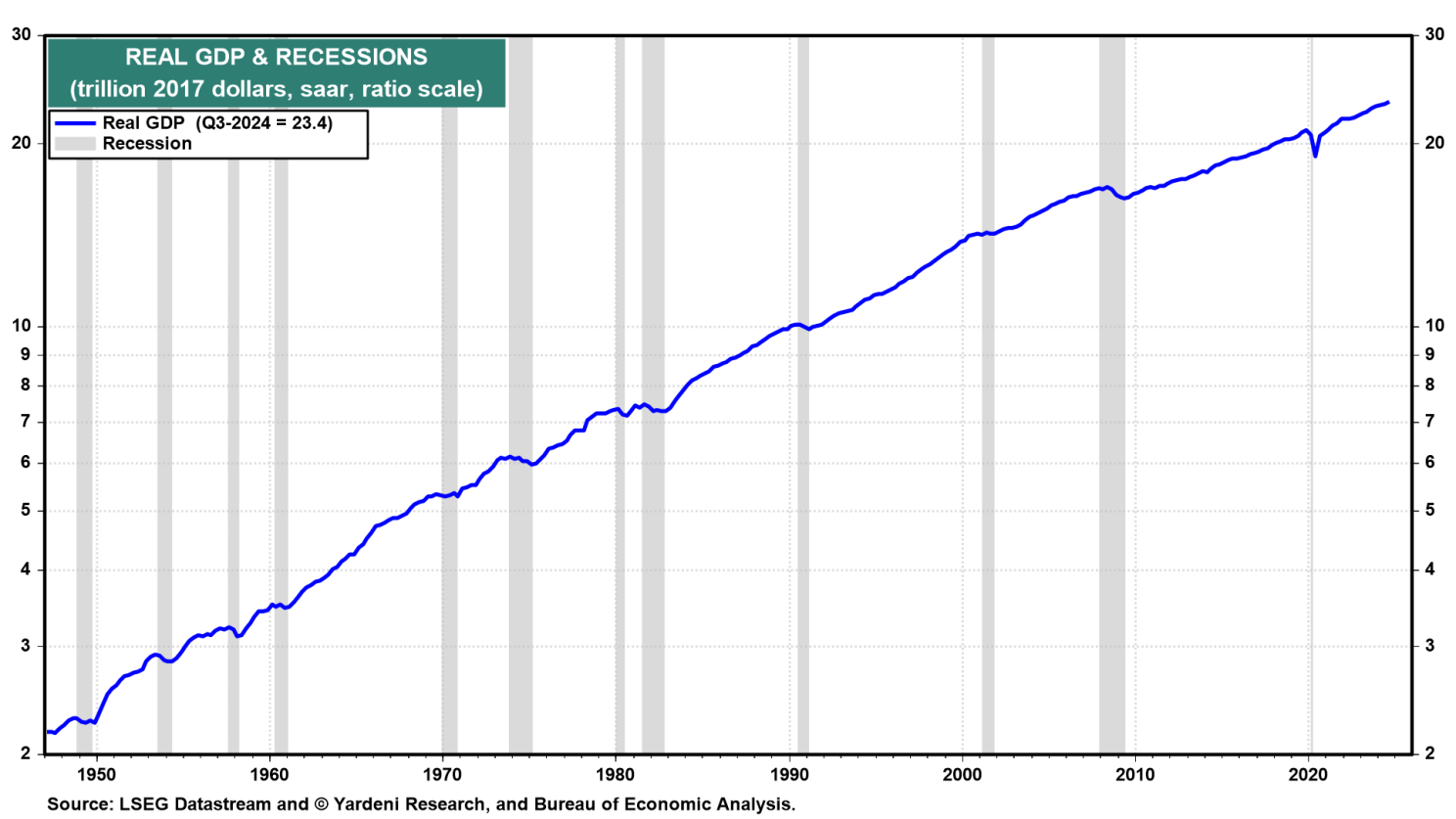
(3) One purpose that bear markets are rare and don’t final very lengthy is that they are usually attributable to recessions
For the reason that finish of World Struggle II, eight of the ten bear markets have coincided with recessions.
(4) Bear-market have stored the secular bull market wholesome for almost a century
In keeping with Looking for Alpha, there have been 28 bear markets within the S&P 500 since 1928, with a median decline of 35.6%. The common size of time was 289 days, or roughly 9.5 months. ABC Information reported that since World Struggle II, bear markets on common have taken 13 months to go from peak to trough and 27 months for the inventory value index to recoup misplaced floor. The S&P 500 index has fallen a median of 33% throughout bear markets over that timeframe.
But the inventory market has been in a secular bull market because the Nice Crash of the early Thirties.
Bear markets serve an necessary operate for bull markets, serving to to flush irrational exuberance out of valuations and permit value indexes to renew their climbs on a sounder footing.
My main grievance with Mr. Roberts’ criticism is that it rests on the unsubstantiated declare that my bullish forecasts normally had been bitten by actuality. To be blunt, Mr. Roberts is uninformed in regards to the accuracy of my forecasting observe report, suggesting that the title of his article is clickbait. He additionally doesn’t appear to know that I all the time acknowledge and focus on the dangers to my base-case forecast and assign subjective chances to it and one or two affordable different situations.
Here’s a transient overview of my forecasting observe report, which frequently—however not all the time—has been optimistic and proper:
(1) Initially of my profession, I used to be bearish in the course of the bear market within the early Eighties. I turned very bullish in August 1982, which was the underside. I didn’t name the August prime of the 1987 bear market, however I did name the underside in December of that 12 months.
I used to be one of many first disinflationists in the course of the Eighties and predicted “hat-size” bond yields when the 10-year yield was nicely above 10%, which I surmised can be bullish for shares. Within the early Nineteen Nineties, I argued that the tip of the Chilly Struggle was bullish for shares. That was a contrarian view on the time.
I used to be among the many first strategists to determine the bullish penalties of the Excessive-Tech Revolution in the course of the early Nineteen Nineties, and I beneficial overweighting the within the S&P 500.
(2) On Could 9,1990, I first predicted Dow 5000 in 1993. It occurred not on time in 1995. Then, I predicted “10,000 by 2000” for the Dow. It occurred forward of schedule on March 29, 1999.
(3) I turned bearish on the Tech sector and the inventory market on the finish of the Nineteen Nineties. I did so for 2 causes. Valuation multiples have been too excessive, suggesting speculative excesses. I anticipated that the Y2K downside may trigger a recession. I used to be proper about that for the incorrect purpose. Everybody mounted the issue by upgrading their {hardware} and software program. In consequence, the demand for these was pulled ahead after which dropped sharply, inflicting a recession firstly of 2000.
After China joined the World Commerce Group on December 11, 2001, I turned bullish on the worldwide financial outlook and on , , and within the inventory market. I turned bearish on throughout June 2007. I wasn’t bearish sufficient as a result of I didn’t anticipate the Fed to let Lehman fail. However in 2009, I known as the inventory market backside on March 9 later that very same month.
(4) Throughout the subsequent bull market, which lasted till the pandemic hit in February 2020, I remained constantly bullish within the face of quite a few selloffs. After the Nice Monetary Disaster in 2008, it was straightforward to alarm buyers about one other bear market. And the permabears did their greatest to just do that. I characterised the frequent sell-offs as panic assaults and compiled an inventory of them throughout that interval, counting 66 all informed throughout that bull market. I remained steadfastly bullish.
(5) I didn’t name the inventory market’s peak on February 19, 2020. However I did name the underside on March 23 a few days later. I anticipated a correction in early 2022. It become a comparatively quick bear market. The market bottomed on October 12, 2022. I recognized that backside later that month and stayed bullish. Now, I’m anticipating a short-lived correction in January 2025.
(6) Initially of 2023 and 2024, Fundstrat and Yardeni Analysis had the very best S&P 500 targets amongst Wall Road’s main analysis outlets (charts).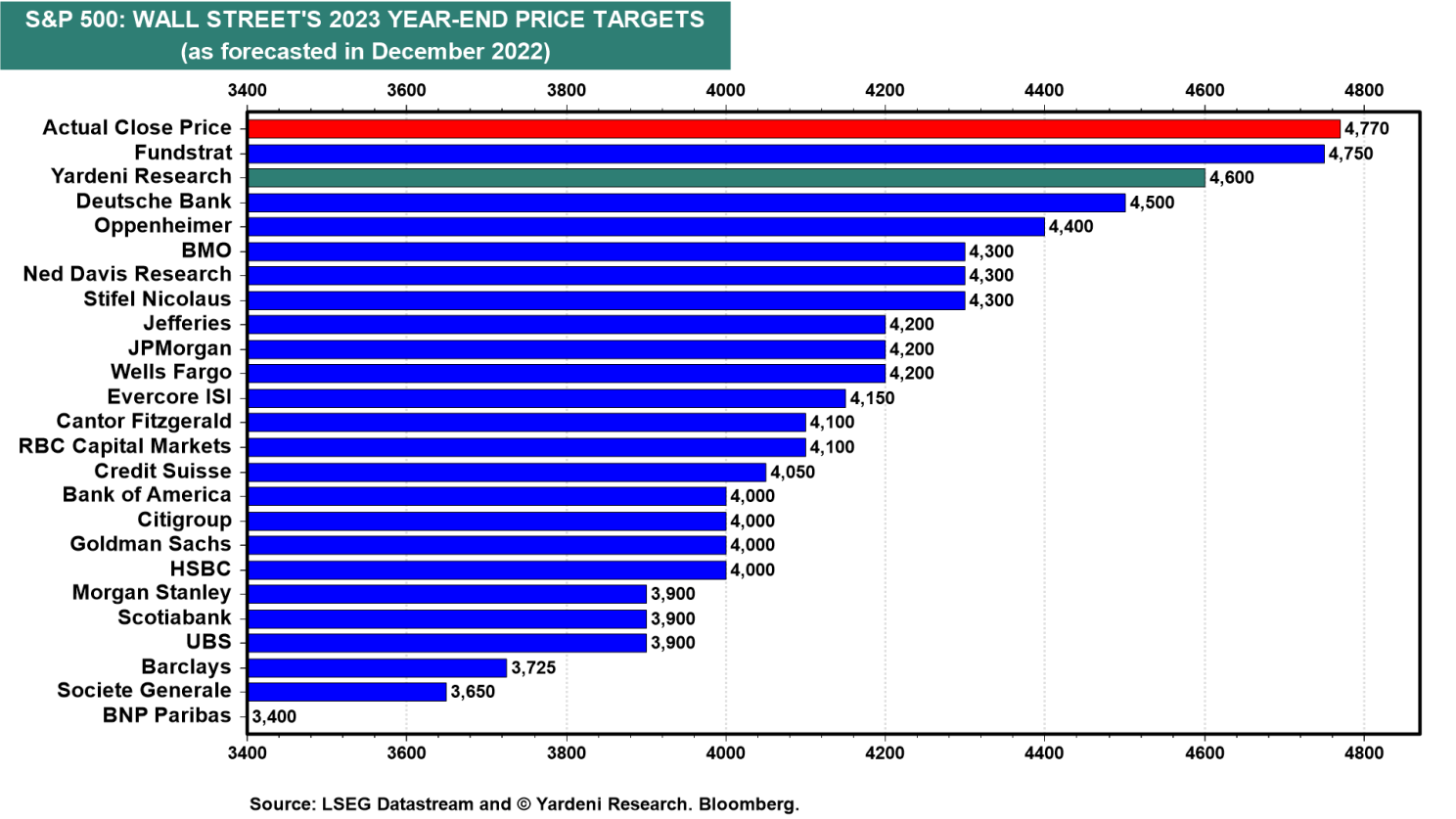
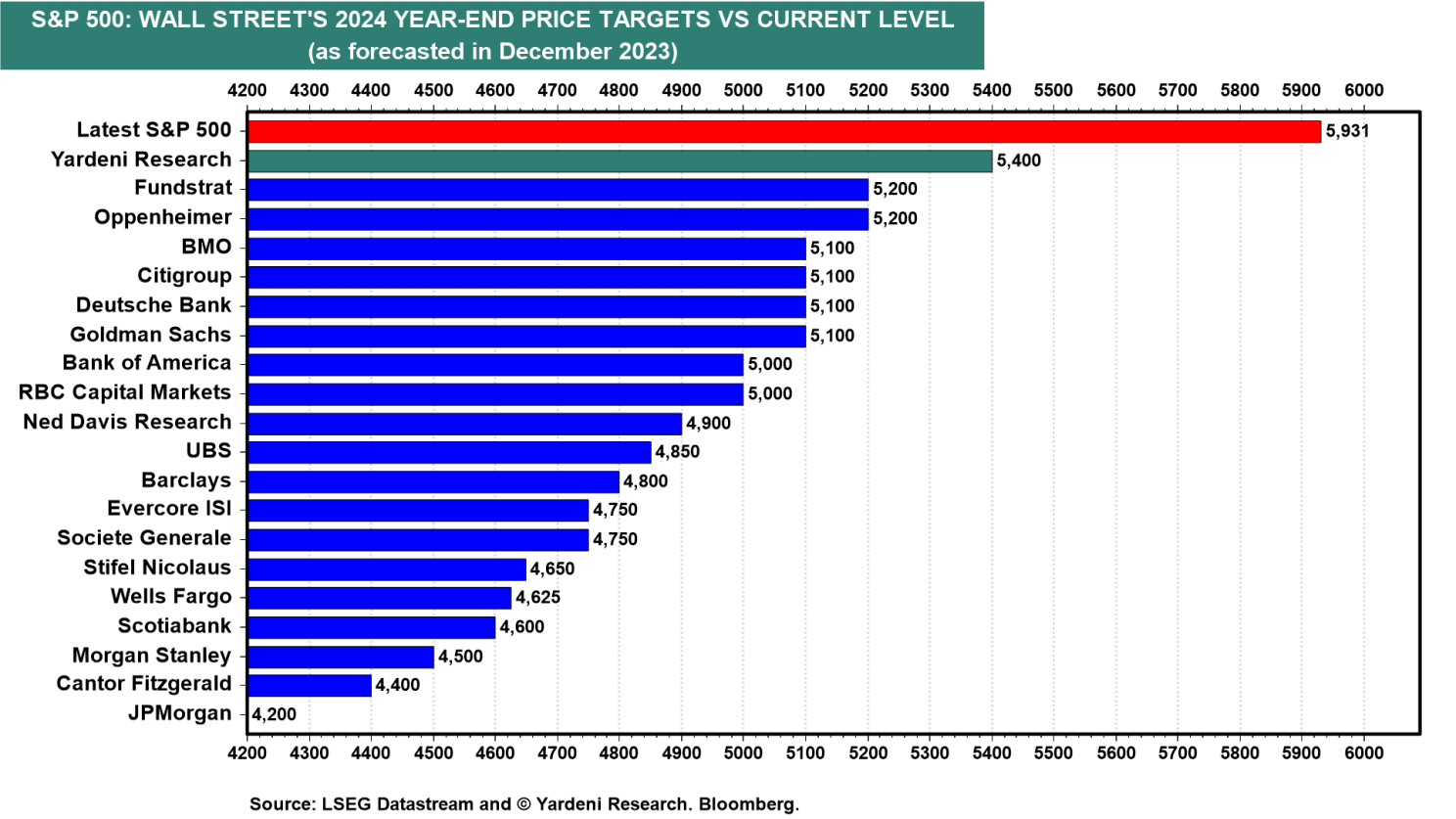
(7) I used to be one of many solely economists appropriately to counter the widespread consensus view that the tightening of financial coverage by the Fed over the previous three years would trigger a recession. I defined that the financial system was experiencing rolling recessions reasonably than an economy-wide downturn.
I countered the widespread notion that customers would retrench as soon as they depleted their $2 trillion of “extra saving,” by observing that retiring Child Boomers have been beginning to spend the $75 trillion of their internet value. I argued {that a} credit score crunch was unlikely, which additionally decreased the chance of a recession.
The Darkish Aspect
In any occasion, no onerous emotions: I just like the permabears. Just a few of them are my buddies. They’re sensible economists and strategists who are usually bearish. I look to them for a radical evaluation of what might go incorrect for the financial system and the inventory market. They’re very vocal and gas numerous pessimism in regards to the future among the many monetary press and the general public. In keeping with Microsoft (NASDAQ:) CoPilot, this permabear crowd consists of such luminaries as Jeremy Grantham, Marc Faber, Harry Dent, David Tice, Albert Edwards, John Hussman, Peter Schiff, Nouriel Roubini, and David Rosenberg.
The economists at Goldman Sachs just lately joined the darkish aspect. They predict that the S&P 500 will produce annualized returns of solely 3% (earlier than accounting for inflation) over the subsequent 10 years. In keeping with the October 25 Briefings from Goldman Sachs (which is publicly accessible): “A very powerful variable on this forecast is beginning valuation. ‘In principle, a excessive beginning value, all else equal, implies a decrease ahead return,’ writes David Kostin, chief US fairness strategist at Goldman Sachs Analysis.”
That implies that beginning valuations now are excessive relative to what they’ll be sooner or later—so it appears to imagine that they’ll be decrease 10 years from now. Nevertheless, that’s clearly a “identified unknown”: We all know that 10 years from now, valuations might be larger, the identical, or decrease than now; however we don’t know which.
Granted, historic requirements stretch present valuation multiples; however in 10 years, they may nonetheless be as excessive as they’re now even with drops alongside the best way. In that case, then over the subsequent 10 years the S&P 500 value index would rise together with its earnings—at a tempo that ought to be no less than twice as quick as Goldman’s 3% annual projection and nearer to 11% together with reinvested dividends (charts). In our Roaring 2020s state of affairs (and perhaps Roaring 2030s), valuations is perhaps larger than they’re as we speak.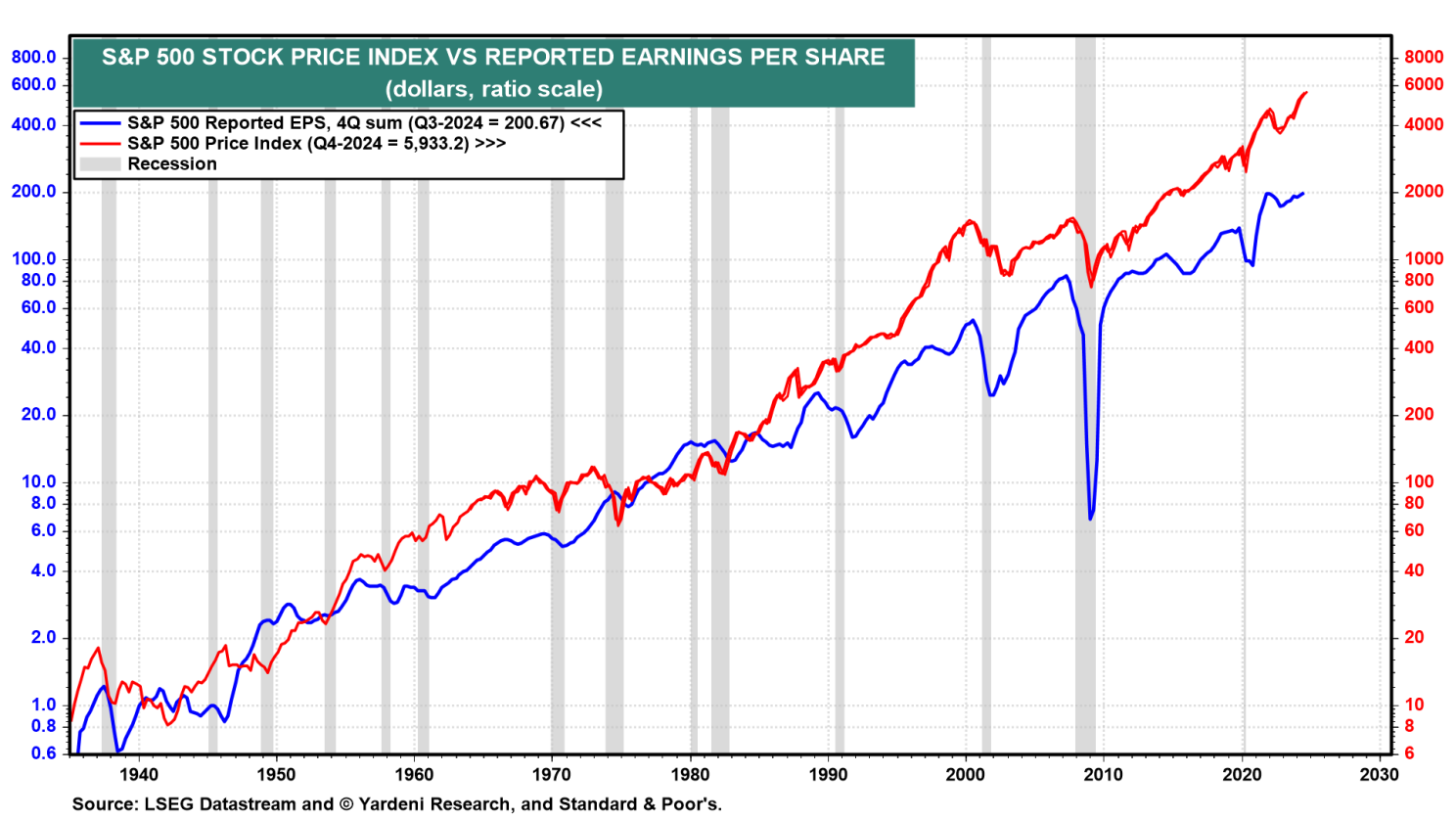
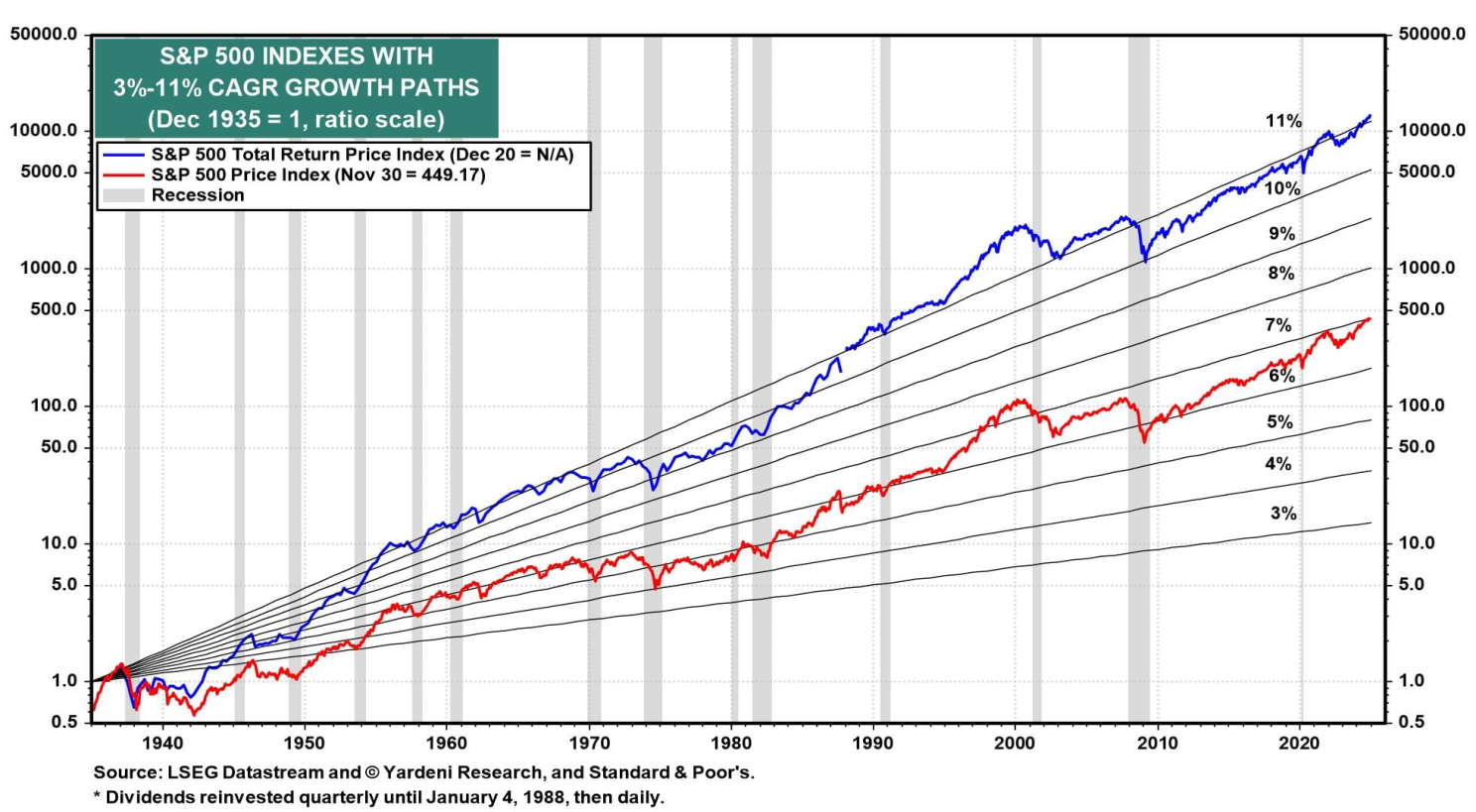
The Power
So let the Power be with you. Nevertheless, you should select whether or not to hitch the darkish aspect or the sunshine aspect of the Power. The permabears have chosen the darkish aspect. Just a few are well-known as a result of they known as a market prime as soon as. They’ve by no means known as market bottoms with just one exception. A very long time in the past in a galaxy far, distant once I was simply beginning my profession, Henry Kaufman, the chief economist of Salomon Brothers, additionally known as the inventory market backside in August 1982 after having been appropriately very bearish on bonds for a number of years.
So the permabears are likely to get you out of the inventory market usually nicely earlier than a major prime. When the market falls, they have a tendency to show extra bearish. Even when they get you out on the prime, they probably gained’t get you again in on the backside. In distinction, permabulls like myself are likely to agree with this outdated adage: “Time available in the market beats timing the market.” In keeping with CoPilot, our crowd consists of Warren Buffett, Jeremy Siegel, Tom Lee, Jim Paulsen, and Brian Belski. Right here’s one other outdated Wall Road adage: “Bears sound sensible, however bulls make you cash.”
For these involved in a extra complete evaluation of my forecasts and the way I formulated them, my 2018 e book titled Predicting the Markets: A Skilled Autobiography is perhaps of curiosity. If you’re my age, it is best to discover it a stroll down Reminiscence Lane. For youthful college students of the market, it’s a great way to make amends for the previous 40-plus years.
Unique Submit



